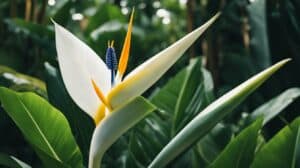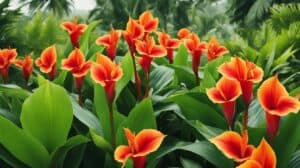Beaucarnea recurvata, commonly known as the Ponytail Palm, is a unique and easy-to-care-for houseplant that is perfect for those who want to add a touch of green to their homes.
Despite its name, the Ponytail Palm is not actually a palm tree, but rather a member of the agave family.
It is native to Mexico and is known for its distinctive appearance, with a bulbous trunk that tapers towards the top and long, thin leaves that resemble a ponytail.

Caring for a Ponytail Palm is relatively simple, making it an ideal choice for those who are new to plant parenting or have a busy schedule.
These plants thrive in bright, indirect sunlight and can even tolerate some direct sunlight.
They prefer well-draining soil and do not require frequent watering, as their thick trunk can store water for long periods of time.
In this article, we will discuss the basic care requirements for a Ponytail Palm and provide tips for keeping your plant healthy and thriving.
Understanding Beaucarnea Recurvata
Species Overview
Beaucarnea Recurvata, also known as Ponytail Palm, is a unique and interesting plant that belongs to the Asparagaceae family.
It is native to Mexico and is widely cultivated as an ornamental plant in many parts of the world due to its unique appearance.
It is a slow-growing plant that can reach a height of up to 30 feet in the wild, although it is usually much smaller when grown indoors.
Common Names
Apart from Ponytail Palm, Beaucarnea Recurvata is also known by several other common names, including Bottle Palm, Elephant’s Foot, and Nolina Recurvata.
These names are derived from the plant’s shape, which resembles a bottle or an elephant’s foot.
Origin and Habitat
Beaucarnea Recurvata is native to the arid regions of Mexico, where it grows in rocky, mountainous areas.
It is well adapted to dry conditions and can survive long periods of drought.
The plant has a thick, swollen base that stores water, allowing it to survive in arid conditions.
In the wild, it is often found growing alongside cacti and other succulent plants.
Overall, Beaucarnea Recurvata is a fascinating plant that is easy to care for and can be grown indoors or outdoors.
With proper care and attention, it can thrive and add a touch of exotic beauty to any space.
Ponytail Palm Basic Care

Ponytail Palm (Beaucarnea recurvata) is an easy-to-care-for houseplant that is native to Mexico.
This plant is also known as the Elephant’s Foot plant, due to its bulbous trunk, and it can grow up to 10 feet tall indoors.
Here are some basic care tips for your Ponytail Palm.
Light Requirements
Ponytail Palm prefers bright, indirect light. It can tolerate low light conditions, but it will grow more slowly.
Direct sunlight can scorch the leaves, so it’s best to keep the plant away from hot windows.
Watering Techniques
Ponytail Palm is a drought-tolerant plant, and it stores water in its bulbous trunk.
Overwatering can cause the roots to rot, so it’s important to let the soil dry out between waterings.
The frequency of watering depends on the size of the plant and the pot, as well as the temperature and humidity of the environment.
As a general rule, water the plant once every two to three weeks in the summer and once every four to six weeks in the winter.
Soil and Potting
Ponytail Palm prefers well-draining soil that is slightly acidic.
A cactus or succulent mix is a good choice, or you can mix regular potting soil with sand or perlite.
The plant can grow in a small pot for several years, but eventually, it will need to be repotted into a larger container.
It’s best to repot in the spring or summer, when the plant is actively growing.
Temperature and Humidity
Ponytail Palm is a tropical plant that prefers warm temperatures and high humidity.
It can tolerate temperatures as low as 50°F (10°C) but it will not grow well in cold conditions.
The plant can benefit from occasional misting or a humidifier, especially in dry indoor environments.
By following these basic care tips, you can enjoy a healthy and happy Ponytail Palm in your home.
Advanced Care Strategies

Fertilization Schedule
Beaucarnea recurvata, also known as the Ponytail Palm, is a slow-growing plant that does not require frequent fertilization.
However, if you want to promote growth and maintain healthy foliage, it is recommended to fertilize the plant once every three to four months during the growing season (spring and summer).
Use a balanced fertilizer with an N-P-K ratio of 10-10-10 or 20-20-20, and dilute it to half strength before applying it to the soil.
Pruning and Maintenance
Ponytail Palms are relatively low-maintenance plants, and pruning is not necessary unless you want to remove dead or damaged leaves.
To do so, use a clean, sharp pair of pruning shears and make a clean cut close to the base of the leaf.
Avoid cutting into the trunk, as this can damage the plant.
In addition to pruning, it is important to regularly dust the leaves of your Ponytail Palm to keep them clean and free of debris.
You can use a soft cloth or a feather duster to gently wipe the leaves, being careful not to bend or break them.
Repotting Tips
Beaucarnea recurvata prefers to be slightly root-bound, so it does not need to be repotted often.
However, if you notice that the plant has outgrown its current container, it can be repotted in the springtime.
Use a well-draining potting mix and a container that is only slightly larger than the current one.
When repotting, be sure to gently loosen the roots and remove any dead or damaged ones before placing the plant in its new container.
Remember to water the newly repotted plant sparingly for the first few weeks to allow the roots to adjust to their new environment.
After that, resume your normal watering schedule.
Troubleshooting Common Issues

Pest Infestations
Ponytail palms are generally resistant to pests, but they can still fall victim to a few common insects.
Spider mites and mealybugs are the most likely culprits.
Spider mites can be identified by the fine webbing they leave on the plant, while mealybugs leave a white, cotton-like substance.
If you notice an infestation, isolate the affected plant immediately to prevent the pests from spreading to other plants.
You can remove spider mites by spraying the plant with water or using a miticide.
Mealybugs can be removed by wiping them off with a cotton swab dipped in rubbing alcohol.
Disease Prevention
Ponytail palms are susceptible to root rot if they are overwatered or planted in soil that doesn’t drain well.
To prevent this, make sure your plant is in well-draining soil and water it only when the top inch of soil is dry.
Another common issue is fungal diseases. To prevent this, avoid getting water on the leaves and make sure the plant has adequate air circulation.
If you notice any signs of fungal disease, such as discolored or mushy leaves, remove the affected leaves and treat the plant with a fungicide.
Leaf Browning and Other Concerns
If the leaves of your ponytail palm are turning brown, it could be a sign of underwatering or low humidity.
Make sure you are watering your plant regularly and consider misting the leaves to increase humidity.
If the leaves are yellowing, it could be a sign of overwatering or nutrient deficiencies.
Make sure you are not watering your plant too frequently and consider adding a balanced fertilizer to the soil.
If the leaves are curling or wilting, it could be a sign of too much direct sunlight or not enough water.
Move the plant to a shadier spot and make sure you are watering it enough.
By addressing these common issues, you can keep your ponytail palm healthy and thriving for years to come.
Frequently Asked Questions

How often should I water my Ponytail Palm?
Ponytail Palms are drought-tolerant plants, and they prefer to be under-watered rather than over-watered.
It’s important to let the soil dry out almost completely before watering it again.
During the growing season, you can water your plant every two to three weeks.
However, during the winter months, when the plant is dormant, you should water it even less frequently.
Can I grow my Ponytail Palm outdoors, and if so, how?
Yes, you can grow your Ponytail Palm outdoors, but only in areas with warm climates. The plant prefers full sun to partial shade and well-draining soil.
It’s important to protect the plant from frost and freezing temperatures, as they can be fatal to the plant.
What’s the best way to repot a Ponytail Palm?
Ponytail Palms prefer to be root-bound, so it’s important not to repot them too often.
When repotting, choose a pot that’s only slightly larger than the current one.
Use a well-draining soil mix, and make sure to water the plant thoroughly after repotting.
How much light is required for a healthy Ponytail Palm?
Ponytail Palms prefer bright, indirect light. They can tolerate some direct sunlight, but too much can burn the leaves.
If your plant isn’t getting enough light, the leaves may turn yellow or brown.
What should I do if my Ponytail Palm has brown tips?
Brown tips on the leaves of a Ponytail Palm are usually a sign of underwatering or low humidity.
To fix the problem, water the plant more frequently and mist the leaves with water to increase humidity.
How can I encourage my Ponytail Palm to grow taller?
Ponytail Palms grow slowly, but you can encourage growth by providing them with bright, indirect light and fertilizing them during the growing season.
You can also prune the plant to remove any dead or damaged leaves, which can help redirect energy to new growth.














